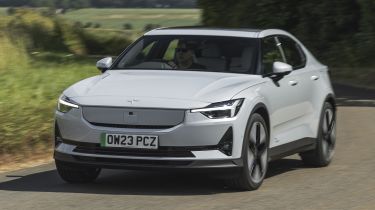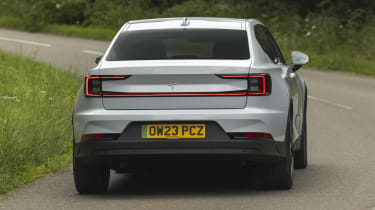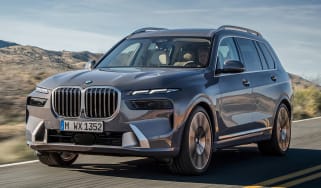Polestar 2 - Electric motor, drive and performance
The Polestar 2 is quick and precise, but it’s too firm for most UK roads

The Polestar 2 updates included efficiency boosts, extra range, and power. The Single-Motor variant switched from front to rear-wheel drive, while Dual-Motor, four-wheel models have a greater rear bias.
Polestar claims the changes have made the 2 “even more fun to drive”, and while that might be true when compared with its predecessor, the car is still no match for the BMW i4. The Polestar 2 isn’t bad in isolation, but body lean is more pronounced than in the BMW, and the Polestar 2 pitches and dives under heavy acceleration and braking, making it feel less agile than its rival. The steering isn’t as responsive as the best setups in this class, either.
Since its launch, the biggest issue we’ve had with the Polestar 2 is that the ride feels too firm for most UK roads, and this still hasn’t been addressed. When you encounter any kind of broken road surface, the car will start to bounce about, causing it to fidget constantly and become rather uncomfortable. It’s even worse in the back, which is bad news for those with children prone to motion sickness. Ride comfort is no better around town, where we found the unforgiving damping causes the car to jump about quite a bit at low speeds. If ride comfort is your priority, then look at the far more compliant Volkswagen ID.7 – especially one with adaptive suspension.
Refinement could also use some work because the Polestar 2 generated the most wind and road noise when tested against the Tesla Model 3 and its closest rivals.
Used - available now

2019 Hyundai
i10
38,755 milesManualPetrol1.0L
Cash £7,490
2017 Honda
HR-V Hybrid
70,277 milesManualPetrol1.5L
Cash £8,790
2024 Kia
EV6
20,984 milesAutomaticElectric
Cash £26,795
2021 BMW
1 Series
36,564 milesManualPetrol1.5L
Cash £17,990We’d also like to see more variability with the regenerative braking, because you only get two settings in the Polestar 2, and you’ve got to delve into the touchscreen in order to change them. The Hyundai Ioniq 6 is far better in this regard, with easily accessible paddles behind the steering wheel giving you various settings from one-pedal driving in its strongest mode, to coasting while on a motorway cruise. The brake pedal feel for the mechanical brakes in the Polestar 2 is very firm at the top of the pedal travel, but we prefer the more progressive feel to the brakes in the i4 and Ioniq 6.
0-62mph acceleration and top speed
The Standard Range Single Motor Polestar 2 produces 268bhp and 490Nm of torque; enough to go from 0-62mph in 6.2 seconds and hit a top speed of 127mph (the same as all Polestar 2s). The Long Range Single Motor only gets a slight power bump up to 295bhp, though torque stays the same. It takes 5.9 seconds to complete the same benchmark sprint.
Even in Single Motor guise, the updated Polestar 2 is quick, thanks to instant throttle response and plenty of power for effortless overtaking.
Upgrading to the Long Range Dual Motor variant adds an extra motor on the front axle for all-wheel drive, yielding a total power output of 416bhp with 740Nm of torque. If that’s not enough get-up-and-go for you, you’ll need to add the Performance Pack. Available exclusively for the Dual Motor variant, this bumps the power up to 469bhp and cuts the range-topping Polestar 2’s 0-62mph time down from 4.3 to 4.0 seconds.










